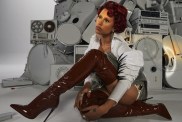As a human who sports a rather large sized head I share a certain sympathy with Australian born sculptor Ron Mueck’s oversized sculptures of humans, with their giant craniums, torsos, faces and feet. Currently on show at the National Gallery of Victoria, from 22 January until 18 April, the exhibition comprises of Mueck’s old and new works, including his seminal work Dead Dad (1996-7).…

The festival landscape has undergone major upheaval in the last three years, and Covid’s long-term impact on the music industry…










